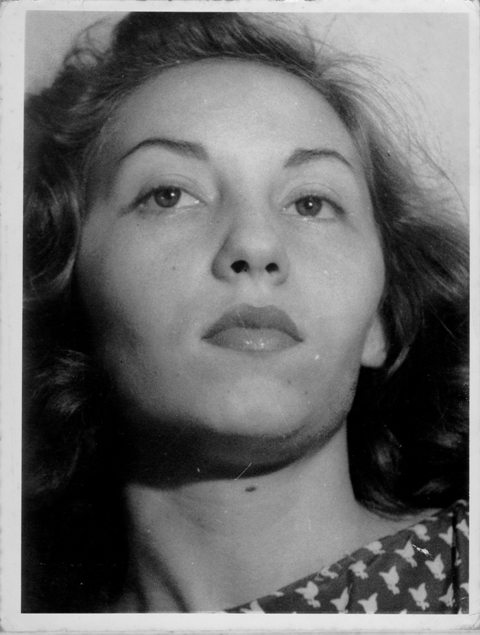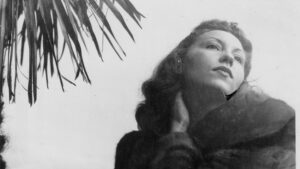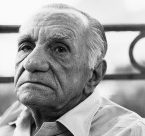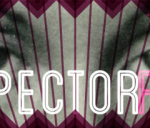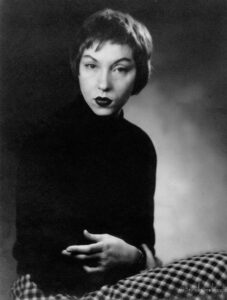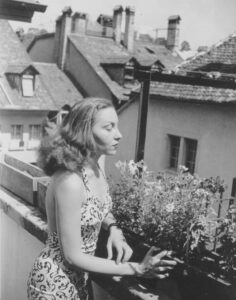, Cazuza to the sound of Lispector. IMS Clarice Lispector, 2018. Disponível em: https://site.claricelispector.ims.com.br/en/2018/10/24/cazuza-ao-som-de-lispector/. Acesso em: 06 January 2026.
“I wanted to announce the following: the person I love most in life is named Clarice Lispector.” This affirmation was made by Cazuza, who was already a bit tipsy, during his participation in a Angela Ro Ro concert at Morro da Urca, in Rio de Janeiro, in 1988.[1] The artist then said to the audience that he would like to sing a “poem” by Clarice that he had set to music. The so-called poem was, in fact, a passage from Água Viva (1973), which was duly adapted to become the lyrics for the song “Que o Deus venha” (May God come).[2]
The songwriter was also inspired by Clarice to compose “A via-crúcis do corpo” (The Via Crucis of the Flesh),[3] based on the book of the same name, which was published in 1974. Beyond these more direct relations, it is possible to find echoes of Clarice in several of Cazuza’s images, as well as in the recurrence of the theme of freedom, which is often projected in a process of apprenticeship through love and through pleasure (such as in An Apprenticeship Or the Book of Delights, from 1969) that is actually constructed through a sort of “unapprenticeship” of established social values.
It is also worth thinking about the proximity between the composer and the writer based on the timeline that connects them. Clarice Lispector’s work spans over 30 years, beginning in the 1940s (with Near to the Wild Heart, in 1943) and ending in the 1970s (with the author’s death in 1977). It can be seen that Clarice lives through a fundamental moment in the history of the 20th century, in a period that offers a glimpse of the bridge that leads from the existentialist discussions and gender debates developed in the first half of the 20th century (especially the respective works of Sartre and Simone de Beauvoir) to the liberation movements of the 1960s and 1970s.
Thus, the existentialist premises that existence precedes essence and that human beings are “condemned” to be free, as well as the understanding that the social roles linked to gender (but also to class, race, and sexual orientation) are socially constructed, allowed new perspectives on the issue of freedom. In this sense, the counterculture of the 1960s and 1970s proposed to contest the values of the bourgeois patriarchal society, refusing the establishment and pointing to new forms of experience. In this group, we should consider not only the hippie and punk movement, and May 1968, but also all of the identity movements that gained force at that moment. In addition, we need to look at the emergence of rock’n’roll and its derivatives, which functioned as the soundtrack for the youth protests of the time.
Cazuza was born in 1958, and was therefore an adolescent during the 1970s, already under the influence of these countercultural movements. Somehow, his work in the 1980s reveals, in a peculiar way, the points of intersection between this universe and that of Clarice Lispector, also shedding light on the historical trajectory that involves all of these expressions. In addition, it is worth considering the impact of AIDS in the 1980s (and of the famous cases of overdose in the 1970s) in relation to these liberation movements, which served as raw material for the song “Ideologia” (Ideology) by Cazuza, released on an album of the same name in 1988, the same year as the show where the artist affirmed his love for Clarice and sang his version of “Que o Deus venha.”
According to a later statement by his bandmate Frejat, Cazuza had given him the draft of the song so that he could make adjustments, provoking surprise by explaining that it was a text by the writer: “I could never have imagined that it was a text by Clarice, since it was so similar to the way he writes.” To understand the similarities, it is worth quoting the original fragment:
I’m restless and harsh and hopeless. Though I have love inside myself. It’s just that I don’t know how to use love. Sometimes it scratches like barbs. If I received so much love inside and nonetheless am restless it’s because I need the God to come. Come before it’s too late. I’m in danger like every person who lives. And the only thing I can expect is precisely the unexpected. But I know that I shall have peace before death and that one day I shall taste the delicateness of life. I shall notice – as we eat and live the taste of food. (LISPECTOR, 2012, p.49)
Cazuza’s adaptation is generally limited to shifting the lyrical I to a male speaker and editing the verses, highlighting the poetic (and musical) nature of Clarice Lispector’s narrative fragment, which undergoes only slight modifications. In relation to the content, it is possible to identify a feeling of disquiet, which is similarly manifested in the work of both the composer and the writer.
Clarice’s characters see themselves faced with three great instances of imprisonment, which can be schematized in the following manner: the social condition (in which gender oppression is especially significant), the human condition (in which the lack of control over one’s destiny is problematic), and finally, language (which tries to apprehend and give meaning to reality). The clash between this convulsive interior world and these limitations provides material for a large part of the writer’s work.
In Near to the Wild Heart (1943), for example, the character Joana affirms: “Freedom isn’t enough. What I desire doesn’t have a name yet.”[4] This celebrated fragment illustrates not only the centrality of this theme in Clarice’s work, but the very clash with language, that is, with the impossibility of giving precise names to the dimensions of the subjective world. In the same book, freedom appears as a heroic option, when it does not appear as an extreme and unnarratable desire, fruit of the anguish caused by the limitations of the human condition and by its likewise limited (and limiting) language – “Freedom? It’s my final refuge, I forced myself to freedom and I bear it not like a talent but with heroism: I’m heroically free. And I want the flow.”[5] In this sense, to “want the flow” would correspond to denying existential, social, and expressional frameworks. The option of being free is heroic to the extent that it carries all the burden of the gauchismo of Rio Grande do Sul, of the pain of not belonging, of the struggle against a pre-established system that is already addicted to pretense.
The title Near to the Wild Heart (1943) itself – whose epigraph reveals a reference to James Joyce, who writes about someone who was alone, “near to the wild heart of life” – already foretells that the narrative will be centered in this subjective, untamable, and disquieted world. It is worth pointing out that a similar universe can be found in iconic songs by Cazuza, such as “Down em mim” (Down in myself) – “Eu não sei o que meu corpo abriga/ nessas noites quentes de verão/ e nem me importa que mil raios partam/ qualquer sentido vago de razão” (I don’t know what my body holds/ on these hot summer nights/ and I don’t even care if a thousand lightning bolts shatter/ any vague sense of reason) and of “Só as mães são felizes” (Only mothers are happy), in which precisely the mother figure is painted in a negative light in relation to the creatures who inhabit “the dark side of life:” “nunca viu Lou Reed/ walking on the wild side” (you’ve never seen Lou Reed/ walking on the wild side) or “você nunca ouviu falar de maldição/ nunca viu um milagre/ nunca chorou sozinha num banheiro sujo/ nem nunca quis ver a face de Deus” (you’ve never heard of curses/ never seen a miracle/ never cried alone in a dirty bathroom/ or ever wanted to see God’s face).
According to critic Benedito Nunes, more than a preoccupation with philosophizing, establishing, or discussing doctrines, there is in the writer’s works “a sensible intuition to write about the threat of anguish that embraces us, when one yearns to live under the sign of the search for freedom.”[6] Without a doubt, this anguish and this disquiet, which are primarily linked to the desire for freedom, are points that profoundly unite the works of Clarice and Cazuza.
As already mentioned, Cazuza was also directly inspired by Clarice Lispector to write “A via-crúcis do corpo” (The Via Crucis of the Flesh), in reference to the writer’s 1974 book of short stories with the same name. The composition revisits Clarice’s universe, not only in general, but also through references to this specific work, such as in the verses: “Só não volta a infância perdida/ só não nos livramos de morrer à toa” (Our lost childhood never returns/ we never free ourselves from dying for nothing), “A dor pode ser disfarçada/ mas a via-crúcis do corpo/ já foi há muito traçada” (Pain can be disguised/ but the Via Crucis of the body/ has long been traced), and “Será que eu tenho um destino?/ Não quero ter a vida pronta/ como um plano de trabalho/ como um sorvete de menta” (Do I have a destiny?/ I don’t want to have a ready-made life/ like a work plan/ like mint ice cream).
The song’s lyrical subject, mirroring the incomplete and disquieted narrator, asks himself about the pain of existence – the Via-Crucis of the body and the soul – and the doubt about human destiny, in which freedom is, at the same time, a blessing and a curse. Note that these verses also echo the book Água Viva, which gave rise to “Que Deus venha,” in which the delimited figure of God reveals the beginning and the end of all things, attributing meaning to life and to death, not only by bringing plenitude and quietude to subjects, but also by offering himself as an interlocutor for the questions about existence. Just as in “Só as mães são felizes,” the creatures on the dark side of life are precisely those who aspire to see God’s face.
The specific fragment that gave rise to “Que Deus venha” touches a point of constant disquiet in Cazuza’s work: the inability to love, which is presented as the composer’s great pathos. The recurring affirmation of not knowing how to love (in tension with his intense desire for a loving relationship) pervades several of his compositions and becomes notorious in the verses “embora amor dentro de mim eu tenha/ só que eu não sei usar amor” (although I have love inside me/ I just don’t know how to use love).
Similar formulations appear in the lyrics to “Malandragem” (Malandroism), “eu sou poeta e não aprendi a amar” (I’m a poet and I haven’t learned how to love); “Rock’n’geral” (Rock’n’general), “ou de um coração meio surdo que não sabe amar” (or from a half-deaf heart that doesn’t know how to love); “Não amo ninguém” (I don’t love anyone), “não amo ninguém e é só amor que eu respiro” (I don’t love anyone and I breathe only love); “Filho único” (Only child), “estou na mais completa solidão/ do ser que é amado e não ama” (I’m so utterly lonely/ being loved but unloving); “Nunca sofri por amor” (I’ve never suffered because of love), “será que nunca amei de verdade/ ou o verdadeiro amor é assim” (maybe I’ve never truly been in love/ or true love is like this); “Carente profissional” (Professionally needy), “levando em frente/ um coração deprimente/ viciado em amar errado/ crente que o que ele sente/ é sagrado/ e é tudo piada” (carrying on/ with a depressing heart/ that’s addicted to misguided love/ that believes what it feels/ is sacred/ and everything is a joke); and “Fracasso” (Failure), “mas eu tenho a impressão/ que todos nós somos fracassados/ eu, por exemplo: não amo…” (but I have the impression/ that all of us are failures/ me, for example: I don’t love…).
In a broad sense, Água Viva speaks of the mystery of the instant that is life and death at the same time – creation and destruction. Beginning with the “alleluia” of a childbirth, the “human howl of the pain of separation,” but which is a “shout of diabolic joy,” speaks of the explosion of birth, of transition, of the existence that occurs in the limit between pain and joy, always advancing to the next instant, which provokes fear and fascination, for it concerns the unknown. The adapted verses of Cazuza concentrate these feelings by pointing out the danger of life, the always unexpected.
It is also worth noting that there are several words that are repeated in this book, as well as in all the writer’s work: “shout,” “burn,” “pulse,” “vibrate,” “flow.” As already mentioned, these words are directly connected to an untamable interior space, which is imprisoned by the limits of the human condition, by the social frameworks that are imposed, and by discourse. This same set of words (or at least their meanings) pervade Cazuza’s compositions to a great extent. Additionally, the “screaming object” that is narrated in Água Viva is also closely related to the rock’n’roll universe, from where the artist takes the nature of his songs and cries.
Finally, it is worth thinking that “the dark side of life,” or that which is found “near to the wild heart,” would not have as much strength if there were not a tension between the sacred and the profane, the cries and the silence, the flux and the limit, transgression and redemption, theft and the rose. And thus, the lyrics that begin with the “harsh,” “disquieted,” and “hopeless” subject projects the hope of finding peace before death, and furthermore, a deep desire for delicacy. And it is in this space of conflict that the works of Cazuza and Clarice Lispector are mutually illuminated.
[1] The audio recording of Angela’s show, in which Cazuza makes this declaration and sings “Que Deus venha,” is available at www.youtube.com/watch?v=X3JzJHJg758. Accessed on 07/2018.
[2] “Que o Deus venha” (Frejat/ Cazuza/ Clarice Lispector). Originally recorded by Barão Vermelho on the album Declare Guerra (1986) and rerecorded by Cássia Eller on Cássia Eller (1990). The only recording with Cazuza’s voice is precisely the informal audio recording from this show by Angela Ro Ro.
[3] “A via-crúcis do corpo” (Cazuza). Text not set to music.
[4] In: Perto do Coração Selvagem (LISPECTOR, 1998:70)
[5] In: Água Viva (LISPECTOR, 1998, p.16)
[6] NUNES quoted in HELENA, 2006:38.

